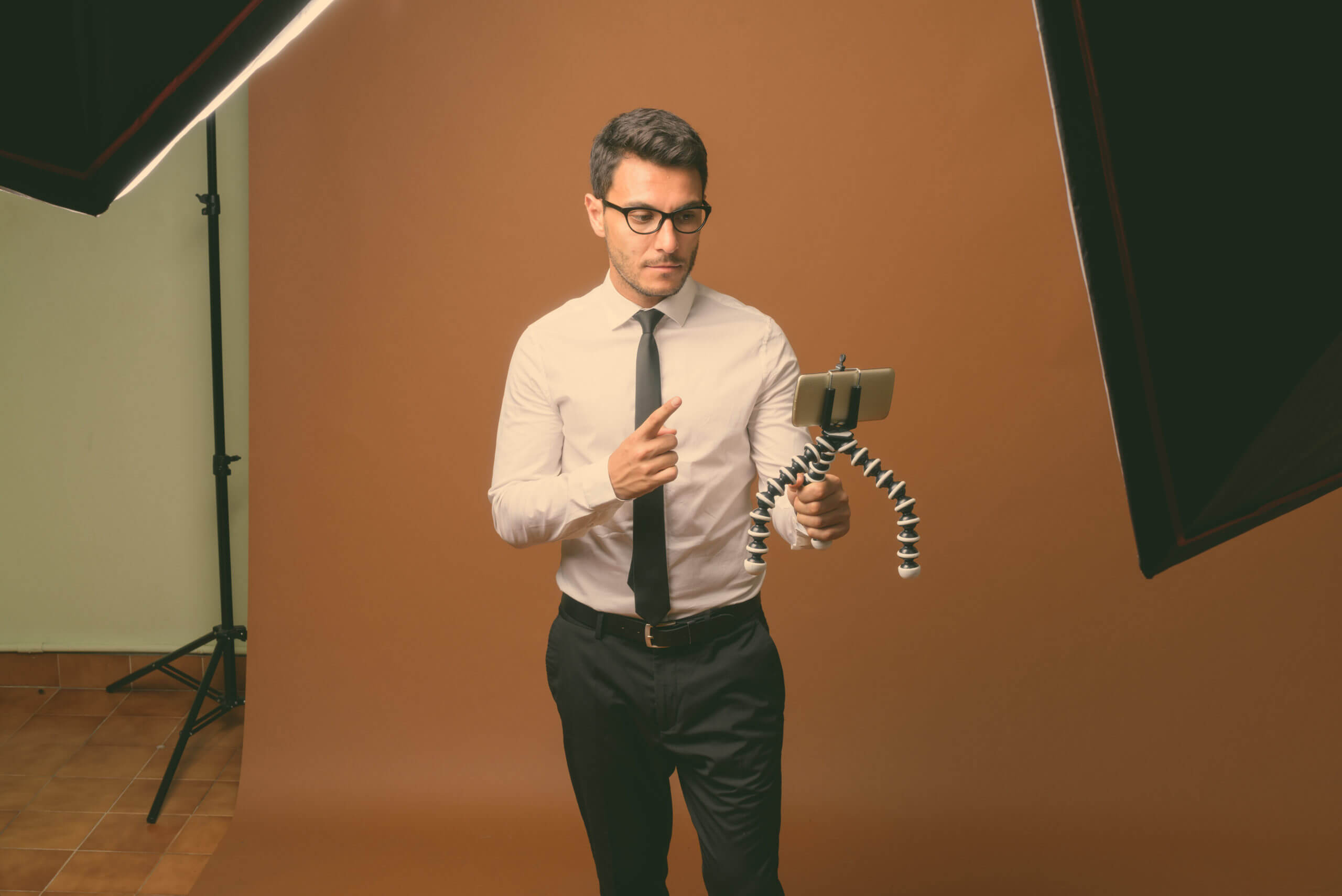
*BING*
Your phone buzzes. Incoming message: Audition notification!
You start scrolling and see it’s not an in-person audition. You must submit a self-tape.
Do self-tapes fill your stomach with dread? Are you intimidated by the self-taping process? Do cameras, microphones and editing software make you break out in a cold sweat?
It’s time to conquer the self-tape once and for all!
The entertainment industry is growing by leaps and bounds. Self-tapes are becoming a more standard part of the casting process. Don’t be left behind because you’ve always hated having to put yourself on tape.
Keep reading this complete guide and you’ll learn why a self-tape audition is the actor’s best friend.
Why so Many Self-Tapes?
Every day the demand for scripted content grows. There are more jobs for actors now than ever before. From internet-only commercials to hundreds of on-air television series. And don’t forget that anyone with an iPhone has the power to shoot an award-winning film. There has never been a better time to be an actor.
With the demand for content so high, it can feel like a race to the finish line. Like you, casting directors are juggling more projects than ever before. Directors and producers are spending more time on set and less time in the audition room.
The only way to keep up is to move casting sessions online. Virtual casting calls are the wave of the future.
Self-Tapes Are the Actor’s Best Friend
Actors get the control back with self-taped auditions.
Self-tape auditions are better for actors because:
- No scheduling conflicts. You’ll never have to miss a self-taped audition because you finally decided to take a vacation or are booked on another gig.
- No racing across town during rush hour.
- You have complete control of the situation. No weirdos distracting you in the waiting room.
- Unlimited takes and do-overs. Keep trying until you get the perfect audition.
The Secret to Booking off a Self-Tape
Every casting director has different requirements for self-taping. The first thing you need to do when you get a self-tape audition is to read the instructions start to finish.
Part of the test is showing that you can follow directions. A casting director will not book an actor if he or she has concerns you won’t be able to follow directions. An actor who causes problems or performs poorly on set is a reflection on casting. Casting directors must protect their reputation and make their clients happy to keep their jobs.
This is why you’ll sometimes see overly detailed self-tape instructions. It may seem like the casting director is being super picky. But it’s actually a test. They’re making sure you won’t let them down if booked. Show that you are a professional who knows that the magic is in the details. Even if you don’t book this job, casting directors will know they can count on you deliver a great audition.
Get off Book
You should memorize that script! You’ll look like a professional and give a better performance. It’s not always possible, but whenever you can — memorize your dialogue. This goes for every audition and not just self-tapes.
Tone & Style
Since you won’t have a casting person to direct you, it’s up to you to embody the tone and style of the project.
If it’s an episodic TV show, watch an episode. You’ll learn tons in a short period of time. You’ll get a feel for the timing, the tone and style of shooting. This is especially necessary when it comes to comedies. An audition for a multi-cam sitcom will look completely different than one for a single cam.
When it comes to commercials, think about the product you’re selling. If it’s toothpaste, you better smile. If it’s a car commercial — keep those hands at 10 & 2 o’clock. Don’t forget to add a “button” to the end of your take as well.
How to Film Your Audition
Most self-tapes can be filmed with your smartphone these days. You don’t need to spend money on a professional video camera. An easy way to elevate the quality of your self-tape auditions is with an inexpensive tripod. You can get one for your phone for less than $10 on Amazon.
When filming remember:
- Always film horizontally. Never turn your phone vertically, unless the casting director has specifically asked you to do so.
- Only you should be on camera.
- Your reader is off-screen.
- Put pets in another room, so they don’t wander into frame.
- Frame yourself. The casting director has likely given you specific framing instructions. But if not shooting from the chest up is a safe bet.
- Keep the camera still. Don’t try any fancy moves, this will distract from your performance.
Find a Great Reader
A fellow acting buddy or someone in the industry is always a good choice. Make sure if you’re working with another actor, they aren’t over-performing and drawing attention away from you.
It’s important to choose a reader who helps and doesn’t hurt your performance. This is especially true when it comes to accents and dialects. Let’s say you’re Australian and the role you’re reading for requires a standard American accent. If your reader is also Australian, you’re going to be working much harder to stick to the American accent.
The gender of your reader doesn’t matter. Males can read female roles and vice versa.
Let There Be Light & Sound
You’re on your own when it comes to lighting and sound quality with self-tape auditions. This is an area where many self-tape auditions meet their doom.
Remember directors and producers are used to studio-quality lighting and sound. You don’t want to turn them off because you didn’t turn on enough lights.=
Natural light in front of your face is best. Shoot your audition during the daytime if you can. Depending on how much natural light your home receives, you may need to turn on additional lights as well. Small at-home lighting kits are relatively inexpensive. They’re a good investment especially if you find yourself taping more frequently.
Tips for improving sound quality:
- Turn off fans and A.C. units before filming.
- Give your pup a treat so he won’t bark.
- Shut windows if you live a noisy street.
- Make sure nothing is covering the microphone.
Always test light and sound before shooting. Remember your audience (casting, producers and director) will likely be watching on a laptop, tablet or phone. You can’t count on them having speakers or headphones. Make sure your tape’s volume is loud enough to be heard through low-quality laptop speakers.
Consider Your Backdrop
A plain white wall works great. You could also hang a blue sheet to get more of that studio look. Make sure you aren’t backlit by a window.
If part of your home will be visible on camera, it should be clean and tidy. Clutter can be distracting. No one wants to see your unmade bed.
Props & Wardrobe
Keep props simple, but use them when they will add to your performance.
- If your character is drinking coffee, grab a mug from your kitchen.
- Don’t mime texting or talking on the phone, use a real one.
- Carry a bag or purse if it’s written in the scene.
Always pay attention to wardrobe instructions. If you don’t have the clothing and can’t borrow it, use whatever you have on hand. Style your hair and make-up as you would for an in-person audition. Don’t skip it because you aren’t leaving the house.
Shooting & Editing
Shoot all your scenes separately. You don’t want awkward moments where you are shifting between scenes on tape. This can be confusing for those watching and may impede your performance.
You should always edit your scenes into one file. Multiple files are easily lost or can end up out of order. This also makes things easier for casting. You can use Quicktime, Filemaker Pro, iMovie or Slatable to edit your scenes together.
Be sure to label your file with your name and the role. Format the file as a .mv4, .mov or .mp4 unless directed otherwise by casting. If you don’t have a computer, don’t worry. There are apps available for your smartphone that can do all these things.
Getting Your Audition to Casting
Your self-tape instructions should have clear details on how to deliver your audition to casting. They may ask you to upload the file directly, like through Casting Frontier’s CF Cast service. This is the simplest and easiest way for casting directors to receive your audition.
If you have a large file and have been instructed to send it via email try using WeTransfer.com. This free file sharing service will quickly email large files.
Never post your audition on a public site like YouTube or Vimeo, unless casting has specifically told you to do so. If you’ve signed an NDA, posting to these sites will violate it. You don’t want to make casting directors upset by not following their instructions.
Many casting directors, writers and producers do not want their materials shared. You should also never share any audition information via social media. Treat all auditions and the materials that come with them as strictly confidential.
Self-Taping by Yourself
Having another person to read with you and guide you through your audition is great. But if you’re under a time crunch, there are a few different ways to tape yourself on your own.
Slatable
If you don’t already know about Slatable, go download this free app right now. Seriously, we’ll wait right here…
Slatable allows you to handle every step of a self-tape audition by yourself, from your smartphone. You can even record the other character’s lines and the app will play them back for you. Add title cards and edit your scenes together in one file all within the Slatable app.
The free version includes a watermark on your video. Most casting directors do not have any issues with this. If you want to get rid of the watermark you can upgrade to SlatablePro for a small one-time fee. SlatablePro offers additional features as well.
Zoom
Another great (free!) solution for self-tapes is using the meeting app Zoom. Zoom is similar to Skype or Facetime. It allows you to connect with another person via computer, tablet or smartphone. Zoom is better because it easily allows you to record your “meeting” aka audition.
To use Zoom, you will need the help of another human. But you can save your buddy the trek across town. Or ask your mom back home in Pennsylvania to read with you.
Since you are connecting online there is no need to have another person in the same room. Find a Zoom buddy and help each other record your self-tape auditions. You’ll love how easy it is once you get the hang of it.
When to Use a Professional Self-Tape Studio
You have all the tools you need to submit a great self-tape right in your pocket. But once in a while, it’s time to call in the pros…
If you’re not comfortable putting yourself on tape find a professional self-tape studio. It’s usually not too expensive. But when you’re submitting self-tapes more often, the costs start to add up. Not to mention you have to schedule an appointment and travel to the studio. It’s much easier to do it yourself on your own time.
Here are a few situations where it makes sense to pay for a professional self-tape:
- You’re traveling and would rather pop into a studio and get it done right away.
- You have to self-tape for a callback and quality is important.
- Someone is jackhammering outside your apartment.
Self-Tapes Are Here to Stay
As your self-taping confidence grows, so will your rate of booking. Don’t let technology intimidate you. Self-tapes aren’t going anywhere. Learn to use the apps that will make the process easier. Do a few practice auditions before you submit your first real one to casting.
Above all, have fun with your self-tapes! You have complete control over this audition. Allow your acting chops and creativity to shine.
Want to get your acting career started? Sign up or login to Casting Frontier and start auditioning today!
Related articles:
Actors: Get Cast Without an Agent in Los Angeles
Brad Pitt and other Acting Greats on the Fear of Public Speaking
Adam DeVine Shares His Inspirational Story




